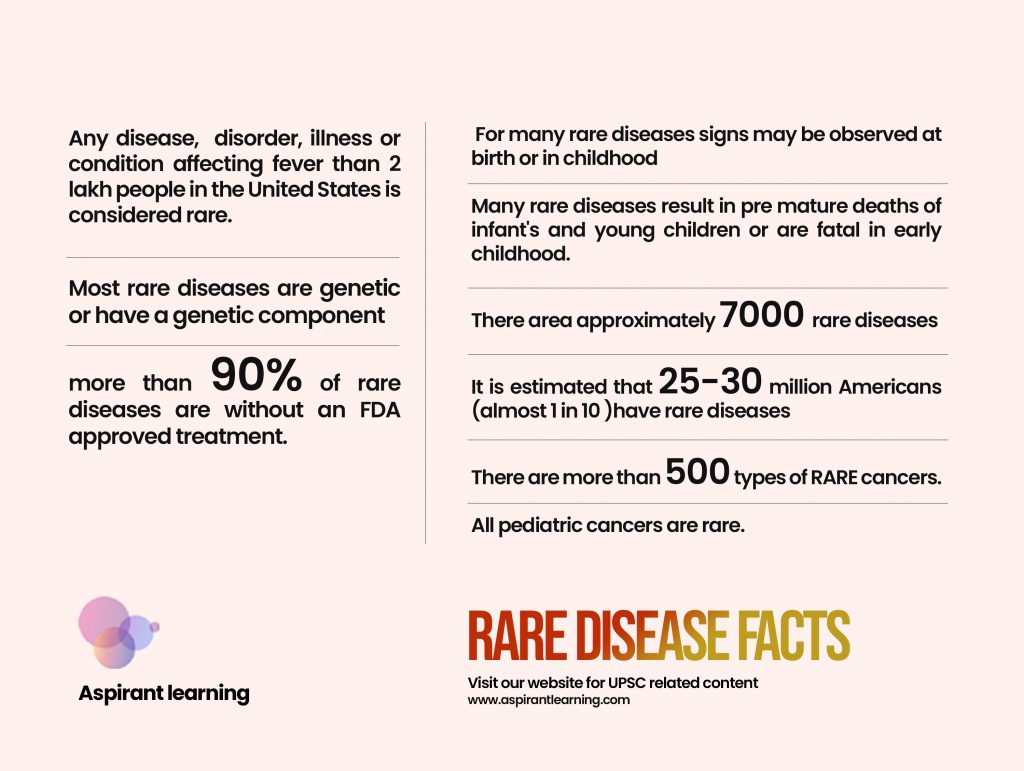News Highlight:
Recently a Rajya Sabha MP has raised concerns over the benefits of the National Policy of Rare Diseases (NPRD) not reaching any patient with rare diseases.
Key Takeaway:
- Issues Raised by the MP:
- Unending delay and lack of urgency have claimed several lives.
- It endangers the survival prospects of patients, largely children diagnosed with rare diseases.
- Most of these patients have been diagnosed with Gaucher disease, for which therapy approved by the Drug Controller General of India has been available for many years.
Rare Diseases
- About
- A rare disease is a disease that affects a smaller percentage of the population compared to other diseases. Its prevalence is very low.
- There is no universally accepted definition of a rare disease.
- The definition accepted in the United States is that it is a disease that afflicts fewer than 2,00,000 people.
- The National Organisation also accepts this definition for Rare Disorders (NORD) in India.
- It is estimated that there are about 7000 rare diseases.
- Some rare diseases are not inherited, such as some rare cancers, some autoimmune diseases, infectious tropical diseases, etc.
- Issues with low prevalence:
- The World Health Organisation defines a rare disease as an often debilitating lifelong disease or disorder condition with a prevalence of 1 or less per 1000 population
- Rare diseases became known as orphan diseases because pharmaceutical companies were not ready to adopt them and develop drugs for them because of their low prevalence.
- That is why the drugs used to treat or manage rare diseases are known as orphan drugs.
- Most of the rare diseases (about 80%) are genetic and hence affect a large number of children.
- Unfortunately, there are no treatments for many rare diseases.

National Policy of Rare Diseases (NPRD):
- About:
- Ministry of Health and Family Welfare formulated and launched NPRD in 2021 to treat rare disease patients.
- Objectives:
- To increase focus on indigenous research and local production of medicines.
- To lower the cost of treatment of rare diseases.
- To screen and detect rare diseases early at early stages, which will, in turn, help in their prevention.
- Key Provisions:
- Categorizing the disorder:
- Group 1: Disorders amenable to one-time curative treatment.
- Group 2: Those requiring long-term or lifelong treatment.
- Group 3: Diseases for which definitive treatment is available, but challenges are to make an optimal patient selection for benefit, very high cost and lifelong therapy.
- Financial assistance:
- Those suffering from rare diseases listed under Group 1 will have financial support of up to Rs. 20 lakh under the umbrella scheme of Rashtriya Arogya Nidhi.
- Rashtriya Arogya Nidhi provides financial assistance to patients living Below the Poverty Line (BPL) suffering from major life-threatening diseases to receive medical treatment at any super speciality Government hospital/institute.
- Beneficiaries for such financial assistance would not be limited to BPL families but extended to about 40% of the population, who are eligible, as per norms of Pradhan Mantri Jan Arogya Yojana, for their treatment in Government tertiary hospitals only.
- Alternate Funding: This includes voluntary crowdfunding treatment by setting up a digital platform for voluntary individual contributions and corporate donors to contribute to the treatment cost of rare disease patients voluntarily.
- Centres of Excellence:
- The policy aims to strengthen tertiary health care facilities for the prevention and treatment of rare diseases by designating eight health facilities as ‘Centres of Excellence
- They will also be provided one-time financial support of up to Rs. 5 crores for the upgradation of diagnostics facilities.
- National Registry:
- A national hospital-based registry of rare diseases will be created to ensure adequate data and comprehensive definitions of such diseases are available for those interested in research and development.
- Categorizing the disorder:
Pic Courtesy: Freepik
Content Source: The Hindu



